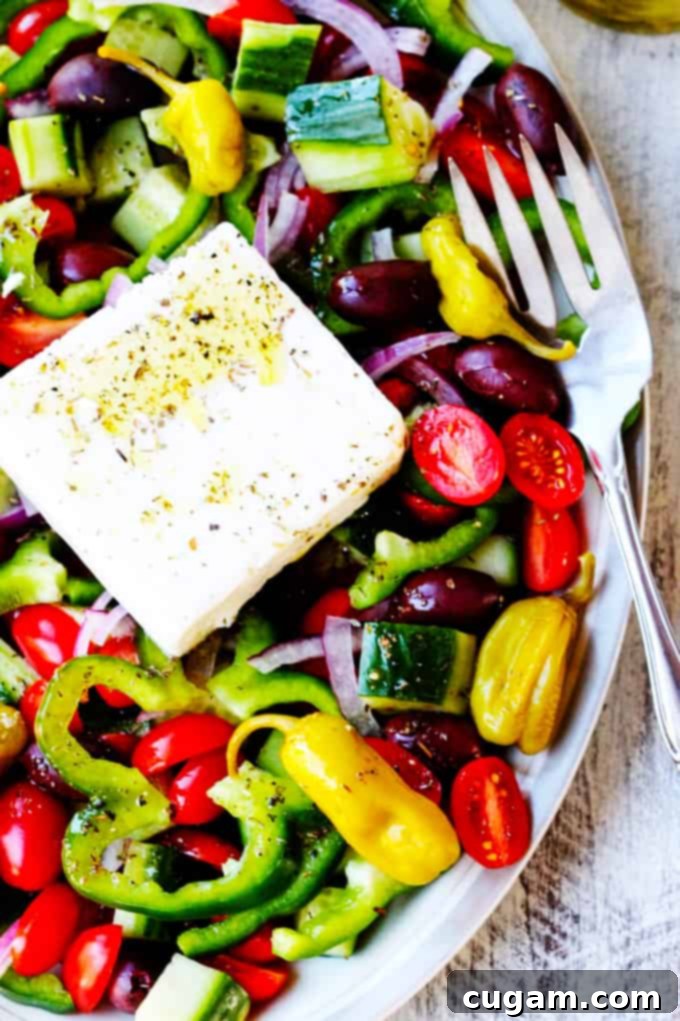Authentic Horiatiki Salad: Your Guide to Crafting the Perfect Traditional Greek Village Salad
There are few dishes as emblematic of Greek cuisine as the Horiatiki Salad, famously known worldwide as Greek Salad or Village Salad. This vibrant, refreshing dish is a celebration of simplicity and the unparalleled freshness of seasonal produce. It artfully combines ripe, juicy tomatoes, crisp cucumbers, vibrant green peppers, sharp red onions, tangy Kalamata olives, and a generous block of creamy, authentic feta cheese. Traditionally dressed with nothing more than the finest extra virgin olive oil and a sprinkle of aromatic dried oregano, it embodies the heart of Mediterranean eating. For those who appreciate a subtle heat, a few mildly piquant Greek peperoncini can add an unexpected yet delightful kick, elevating the flavor profile even further.
While Horiatiki Salad stands as a quintessential Greek culinary experience, its versatility means there’s always room to explore. If you’re a fan of fresh, flavorful salads, you might also enjoy a bright Tomato Feta Salad with fresh mint, offering a slightly different aromatic twist, or the amazing Greek Panzanella with Garlic Lemon Vinaigrette, which masterfully incorporates bread for a heartier, textural delight.
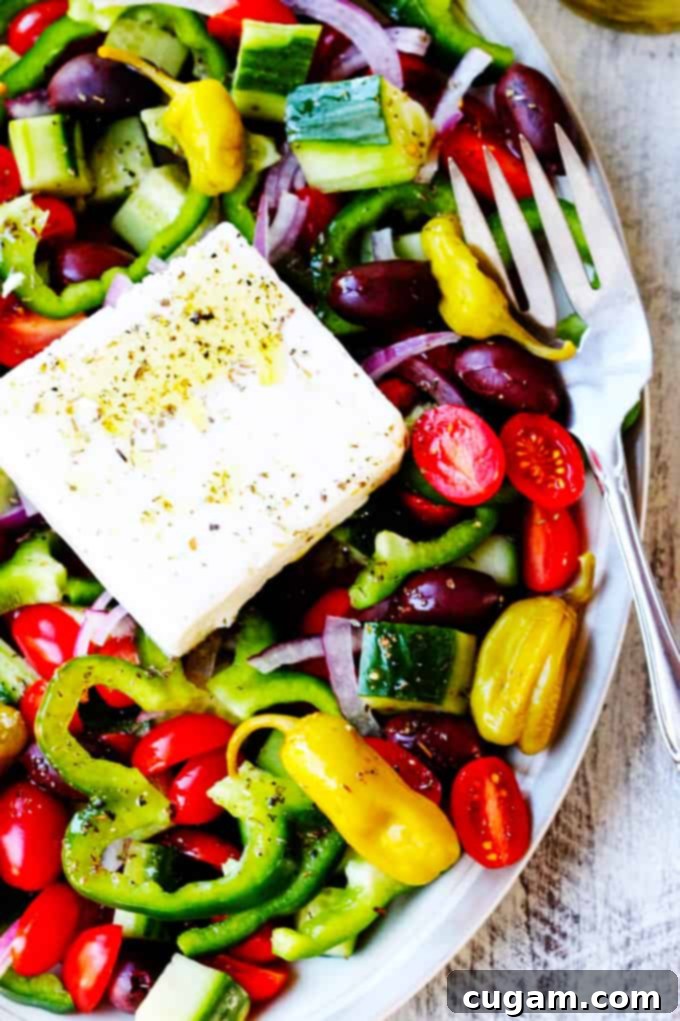
What is Horiatiki Salad? The True Greek Salad Explained
At its core, Horiatiki Salad translates to “village salad,” a name that perfectly encapsulates its humble origins and reliance on the freshest ingredients found in a Greek villager’s garden. It is, unequivocally, what is widely recognized in the US as Greek Salad, though with one crucial distinction that we’ll explore shortly. This isn’t just any salad; it’s a testament to the belief that the best dishes often require the fewest, yet highest quality, components.
The beauty of Horiatiki lies in its seasonality. It truly shines from late spring through early fall, aligning with the peak harvest times for tomatoes, cucumbers, and peppers. During these months, the vegetables burst with natural sweetness and vibrant flavors that cannot be replicated by out-of-season produce. Imagine the sun-drenched fields of Greece, where these ingredients are grown – that’s the essence you’re trying to capture in every bite.
While purists often insist on large, meaty beefsteak or Roma tomatoes, sliced generously to release their juices, I am a huge proponent of using whatever is in season and at its prime. For instance, when this recipe was first developed in late July on the East Coast of the US, large tomatoes were not quite ready, but small, sweet cherry tomatoes were abundant in gardens. Utilizing these delicious cherry tomatoes ensures that the salad is always made with the best available produce, even if it deviates slightly from the classic aesthetic. In fact, good quality cherry tomatoes are often available year-round, allowing you to enjoy this delightful salad even when traditional varieties are not at their peak.
Regardless of the tomato size, the golden rule of Horiatiki Salad remains: a real Greek salad never contains lettuce! This is a common misconception outside of Greece, where many “Greek salads” are served over a bed of leafy greens. In Greece, the focus is entirely on the robust vegetables, the salty feta, and the rich olive oil, allowing their natural flavors to meld and shine without any watery filler.
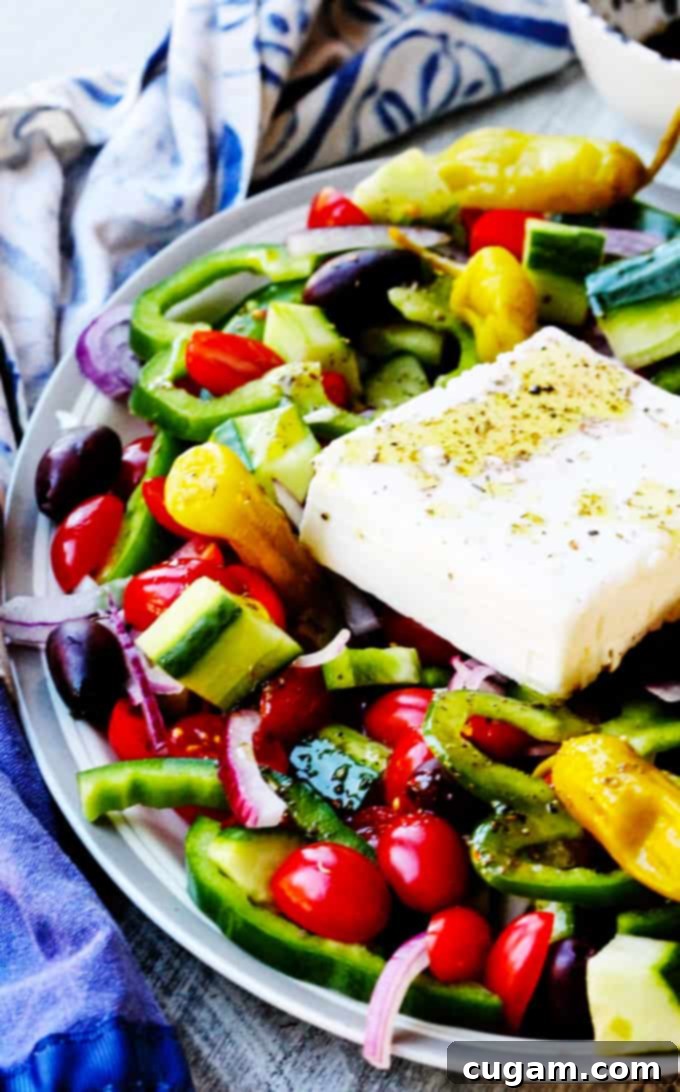
The Essential Ingredients of an Authentic Greek Salad
Crafting an authentic Horiatiki Salad is all about selecting the right ingredients and allowing their inherent quality to be the star. Here’s a detailed look at what goes into a true Greek Village Salad:
- Tomatoes: The foundation of any great Horiatiki. Look for ripe, fragrant, and slightly soft tomatoes. While large beefsteak or Roma tomatoes are traditional, sliced into generous chunks to release their precious juices, any sweet, ripe tomato will do. Cherry or grape tomatoes, halved, offer a burst of flavor and a lovely texture, especially when larger varieties are not in season.
- Cucumbers: Crisp and refreshing, cucumbers add a vital coolness. English cucumbers are often preferred for their thinner skin and fewer seeds, meaning less peeling and deseding. If using traditional field cucumbers, you might want to partially peel them and scoop out some of the seeds for a less watery texture. Cut them into substantial, bite-sized pieces.
- Green Bell Peppers: Crucially, only green bell peppers are used in traditional Horiatiki. Their slightly bitter, earthy flavor provides a perfect contrast to the sweetness of the tomatoes and the richness of the olive oil. Avoid red or yellow peppers, as their sweetness alters the classic flavor profile. Slice them into rings or thin strips.
- Red Onion: A few thin slices of red onion add a pungent bite and beautiful color. If you find raw red onion too strong, you can soak the slices in ice water for 10-15 minutes before adding them to mellow their intensity without sacrificing their flavor.
- Kalamata Olives: These dark, almond-shaped olives are a non-negotiable component. Their briny, fruity, and slightly smoky flavor is essential. Choose good quality, unpitted Kalamata olives if you don’t mind the pits, as they tend to retain more flavor. Otherwise, pitted ones work just as well.
- Good Quality Sheep’s Milk Feta: This is perhaps the most important ingredient. True Greek feta is made from sheep’s milk (or a combination with goat’s milk) and is always served as a solid block, placed on top of the salad, rather than crumbled. Its creamy texture and salty tang are paramount. Avoid pre-crumbled feta, which often lacks the authentic flavor and texture. Look for feta sold in brine, as this preserves its freshness and taste.
- Good Quality, Fragrant Extra Virgin Olive Oil: The dressing for Horiatiki is minimal, which means the quality of your olive oil is paramount. A fragrant, robust extra virgin olive oil, preferably from Kalamata (the region, not just the olives!), will make all the difference. It coats the vegetables, bringing their flavors together and adding a luxurious mouthfeel.
- Red Wine Vinegar: A splash of red wine vinegar provides a necessary tang and acidity, balancing the richness of the olive oil and the saltiness of the feta and olives. Use sparingly, as you want to enhance, not overpower, the natural flavors.
- Lots of Dried Oregano: Greek oregano is renowned for its potent, earthy aroma and flavor. Don’t be shy with it! A generous sprinkle over the entire salad, especially over the feta and olive oil, is traditional and essential.
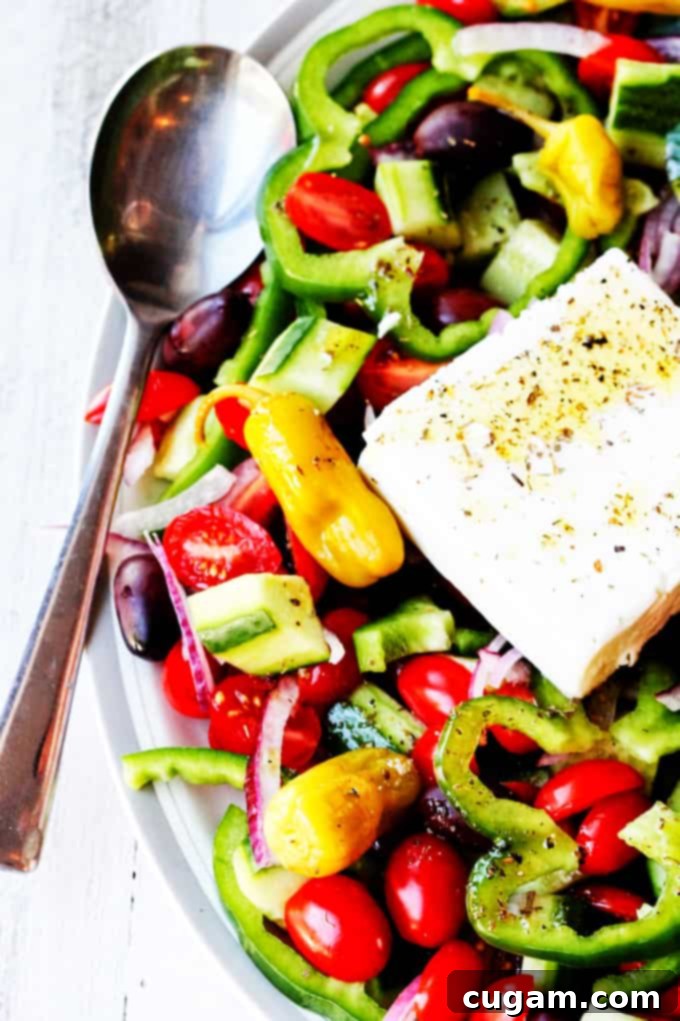
The Secret Kick: Adding Greek Peperoncini for an Enhanced Experience
While the traditional Horiatiki Salad is absolutely perfect in its pure, unadorned form, there’s a delightful secret that can elevate it to a new level: the inclusion of Greek peperoncini. These mildly piquant, slightly sweet, and tangy peppers introduce a subtle warmth and an intriguing complexity that can truly transform the dish.
My personal journey with this addition began during my visits to the Greek islands. Each time I landed, my first craving was always for a fresh Horiatiki Salad – the combination of crisp vegetables, fragrant olive oil, and sharp vinegar was, to me, perfection. That was until a memorable experience in a Greek Tavern in New York. To my surprise and eventual delight, my beloved Horiatiki Salad arrived with peperoncini. I was instantly blown away by the unexpected yet harmonious burst of flavor they brought.
Ever since that revelation, Greek peperoncini have become a staple in my Horiatiki Salads. You can add them whole for a visual appeal and a gentle heat, or chop them finely to distribute their flavor throughout every bite. Pre-chopped varieties are also available for convenience. Their fruity, slightly vinegary notes cut through the richness of the feta and olive oil, adding a layer of zesty brightness that is incredibly addictive. Don’t hesitate to give it a try – I’m confident you’ll love this “extra kick” as much as I do!
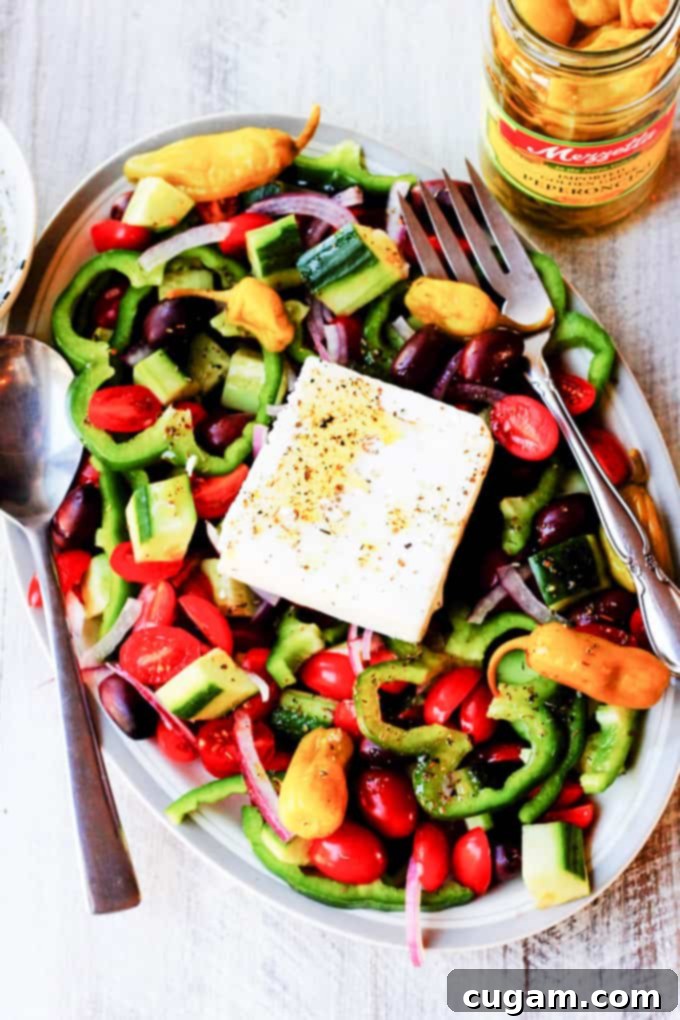
Step-by-Step Guide to Making the Perfect Horiatiki Salad
Making Horiatiki Salad is incredibly straightforward, emphasizing fresh ingredients over complex techniques. Here’s how to assemble this classic Greek dish:
- Prepare the Tomatoes: If using cherry tomatoes, halve them. For larger tomatoes like Roma or beefsteak, cut them into approximate 1-inch cubes. The goal is bite-sized pieces that release their juices.
- Dice the Cucumber: Partially peel your cucumber (or fully peel if preferred) and cut it into cubes similar in size to your tomatoes. This ensures a consistent texture throughout the salad.
- Slice Peppers and Onions: Slice the green bell pepper into thin rings or strips. Do the same for the red onion, ensuring the slices are fine enough to not overpower the other flavors.
- Combine and Add Olives & Peperoncini: Place all the prepared vegetables into a large mixing bowl. Add the Kalamata olives and the peperoncini (whole or chopped, as preferred).
- Whip Up the Dressing: In a separate small bowl, whisk together the extra virgin olive oil, red wine vinegar, dried Greek oregano, salt, and freshly ground black pepper until well combined.
- Dress and Serve: Pour the dressing generously over the vegetables, olives, and peperoncini. Gently toss the salad to ensure all ingredients are lightly coated. Transfer the salad to a serving dish, then crown it with a glorious block of feta cheese. Serve immediately, ideally with some crusty bread to soak up the flavorful juices at the bottom of the bowl.
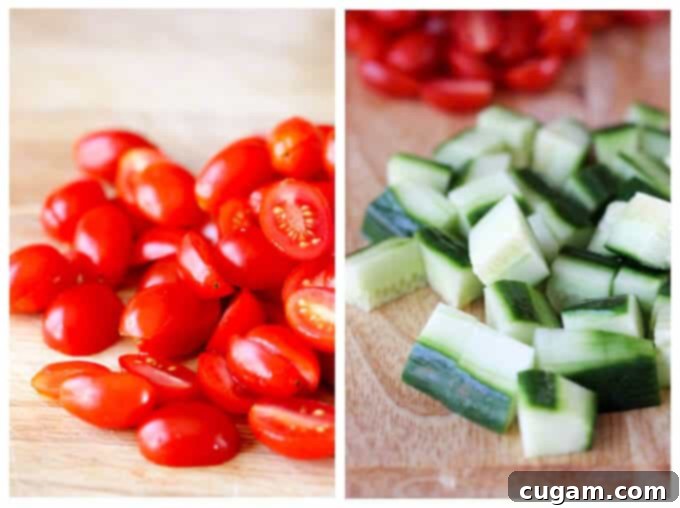
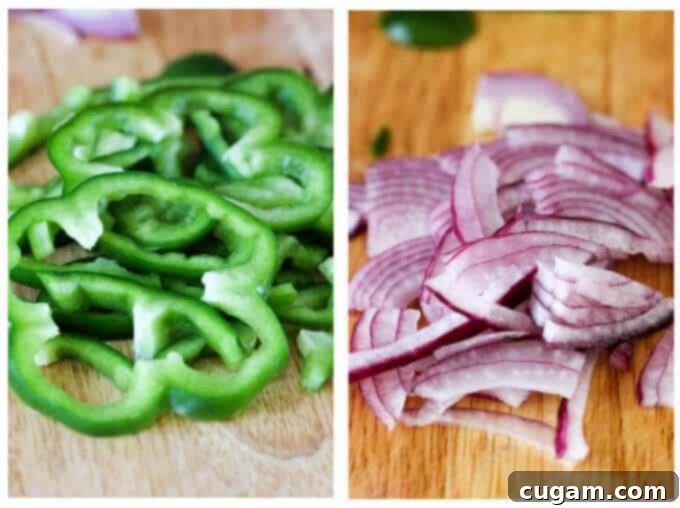

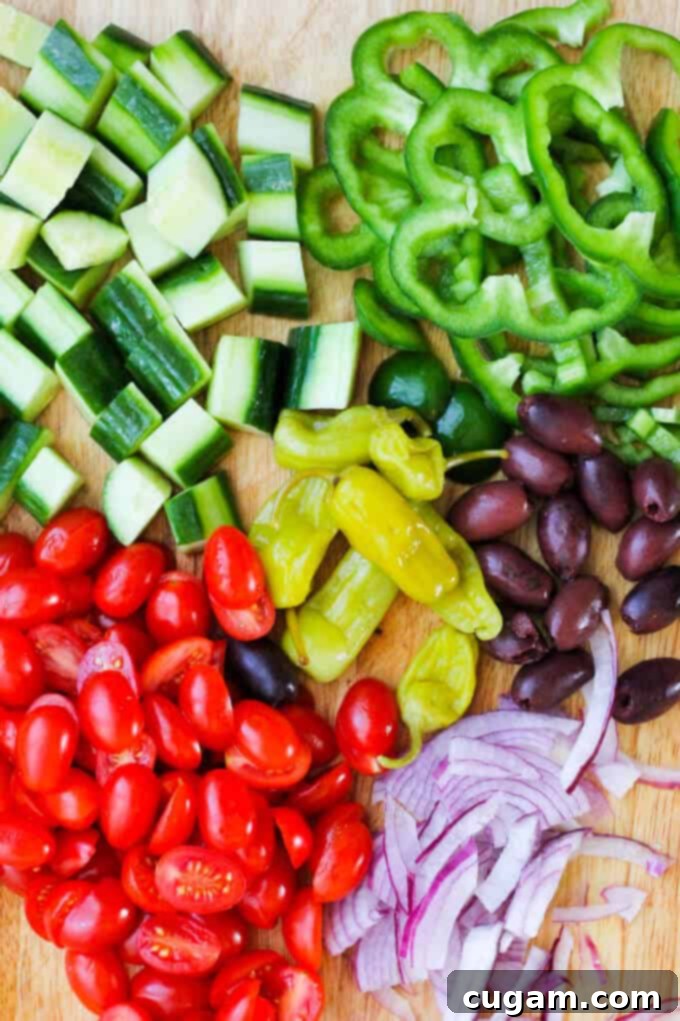
What to Serve Horiatiki Salad with: Perfect Pairings
The beauty of this authentic Greek Salad lies in its incredible versatility. Its refreshing, tangy, and savory flavors make it an ideal accompaniment for almost any meal. Whether you’re grilling, roasting, or preparing a vegetarian feast, Horiatiki Salad adds a burst of freshness and Mediterranean charm. It’s particularly wonderful for cutting through the richness of grilled meats or balancing heartier dishes.
Here are some of my top suggestions for perfect pairings:
- Mediterranean Chicken Kebabs: The vibrant flavors of the salad complement grilled chicken beautifully.
- Pork BBQ Souvlaki: The freshness of the Horiatiki is a perfect counterpoint to the savory, marinated pork.
- Mediterranean Pan Fried Haddock: A light, flaky fish dish pairs wonderfully with the crisp vegetables.
- Grilled Chicken Shawarma: The salad’s acidity and freshness are fantastic alongside spiced chicken.
- Greek Lemon Potatoes: A classic combination that is always a crowd-pleaser.
- Mujadara (Rice and Lentils): Adds a refreshing element to this comforting, earthy dish.
- Mushroom Black Bean Veggie Burger: A great way to add a healthy, flavorful side to a veggie burger.
More Greek Culinary Delights to Explore
If you’re eager to delve deeper into the rich and diverse world of Greek cuisine, here are some other delicious recipes worth trying:
- Kolokithopita – Greek Zucchini Pie
- Kolokithokeftedes – Greek Zucchini Fritters
- Melitzanosalata – Greek Eggplant Dip
- Vegetarian Moussaka
- Traditional Greek Tzatziki
- Greek Lentil Soup with Feta
- Greek Chickpea Soup – Revithosoupa
- Greek Spinach Rice with Feta
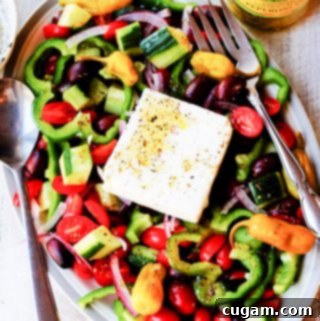
Horiatiki Salad (Greek Salad or Village Salad)
Print
Pin
Rate
Ingredients
- 2 cups Tomatoes halved or cubed
- 2 cups Cucumber English, cubed
- 1 Bell Pepper green, sliced
- 1/2 Red Onion medium, sliced
- 1/2 cup Olives Kalamata
- 1/2 cup Peperoncini
- 7 oz Feta cheese in a block
Dressing
- 1/2 cup Olive oil extra virgin
- 2 tbsp Vinegar red wine
- 1 teaspoon Dry oregano
- 1/2 teaspoon Salt
- 1/2 teaspoon Black Pepper freshly ground
Instructions
-
If using cherry tomatoes, then cut them in half. If using Roma or Beefsteak tomatoes, cut them in 1-inch cubes;
-
Partially peel a cucumber and cut it into cubes, similar in size to the tomatoes;
-
Cut the Bell pepper and onion in thin slices or rings;
-
Place the vegetables into a bowl, then add olives and pepperoncini;
-
Combine all dressing ingredients and pour over the salad; then mix well and place onto a serving dish;
-
Top salad with a block of feta & serve immediately (or sooner) with crusty bread.
Notes
Nutrition
This post was originally published on August 1, 2017, and has since been updated to provide additional comprehensive information and enhance your culinary experience.
Read more about the author Edyta here or follow Eating European on social media for more delicious recipes and European inspirations: Facebook, Instagram, Pinterest, and Twitter.
